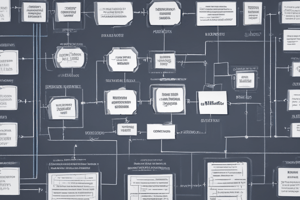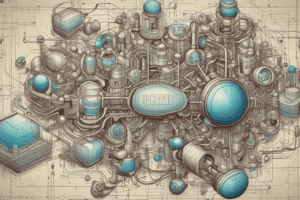Podcast
Questions and Answers
Which of the following is NOT a typical component of a Requirements Traceability Matrix (RTM)?
Which of the following is NOT a typical component of a Requirements Traceability Matrix (RTM)?
- Test Cases
- Requirement Description
- Stakeholder Satisfaction Score (correct)
- Design Reference
What is the primary benefit of using UML diagrams in conjunction with an RTM?
What is the primary benefit of using UML diagrams in conjunction with an RTM?
- To create a visual representation of how requirements are implemented in the system design. (correct)
- To automatically generate code from requirements.
- To reduce the number of system requirements.
- To eliminate the need for test cases.
What type of traceability ensures that each design component can be traced back to a specific requirement?
What type of traceability ensures that each design component can be traced back to a specific requirement?
- Lateral Traceability
- Diagonal Traceability
- Forward Traceability
- Backward Traceability (correct)
What is the purpose of 'Methods/Operations' in a class diagram?
What is the purpose of 'Methods/Operations' in a class diagram?
Which of the following is a challenge associated with combining UML diagrams and RTM?
Which of the following is a challenge associated with combining UML diagrams and RTM?
In the context of system design, how do class diagrams aid in managing system complexity?
In the context of system design, how do class diagrams aid in managing system complexity?
What does the 'Status' component in a Requirements Traceability Matrix (RTM) indicate?
What does the 'Status' component in a Requirements Traceability Matrix (RTM) indicate?
What do 'attributes' represent within a class in a UML diagram?
What do 'attributes' represent within a class in a UML diagram?
In a class diagram, what is the key difference between aggregation and composition?
In a class diagram, what is the key difference between aggregation and composition?
Consider a Vehicle and Driver class in the Hitchin a Ride app. If a Driver can register multiple Vehicle instances, which type of relationship best describes their association?
Consider a Vehicle and Driver class in the Hitchin a Ride app. If a Driver can register multiple Vehicle instances, which type of relationship best describes their association?
In object-oriented design, what is the primary purpose of using 'protected' access modifier for a class attribute?
In object-oriented design, what is the primary purpose of using 'protected' access modifier for a class attribute?
The Hitchin a Ride app has User, Rider, and Driver classes. Given that both riders and drivers are types of users, which class relationship would be most appropriate?
The Hitchin a Ride app has User, Rider, and Driver classes. Given that both riders and drivers are types of users, which class relationship would be most appropriate?
A Ride class includes attributes like fare, pickup location, and drop-off location. Which of these would likely need careful consideration regarding data privacy and security?
A Ride class includes attributes like fare, pickup location, and drop-off location. Which of these would likely need careful consideration regarding data privacy and security?
In UML, what is the primary purpose of a Use Case Diagram?
In UML, what is the primary purpose of a Use Case Diagram?
Which type of relationship in a Use Case Diagram specifies mandatory additional functionality to a base use case?
Which type of relationship in a Use Case Diagram specifies mandatory additional functionality to a base use case?
What does the 'Extend' relationship represent in a Use Case Diagram?
What does the 'Extend' relationship represent in a Use Case Diagram?
In the context of the hotel booking application, what would be considered an actor?
In the context of the hotel booking application, what would be considered an actor?
Why is a Requirements Traceability Matrix (RTM) important in software development?
Why is a Requirements Traceability Matrix (RTM) important in software development?
Considering the hotel booking app described, which of the following would be best represented as a use case?
Considering the hotel booking app described, which of the following would be best represented as a use case?
What role does UML serve in the overall software development process?
What role does UML serve in the overall software development process?
In the context of booking a hotel room using the app, if 'Making a Payment' can either be 'Paying with a Credit Card' or 'Paying Upon Arrival', how would you represent this in a Use Case Diagram?
In the context of booking a hotel room using the app, if 'Making a Payment' can either be 'Paying with a Credit Card' or 'Paying Upon Arrival', how would you represent this in a Use Case Diagram?
Flashcards
UML
UML
A standardized way to visualize the design of a system, aiding understanding and communication.
Use Case Diagram
Use Case Diagram
A diagram that visually represents the interactions between actors and the system's functionalities.
Actors (in Use Case Diagrams)
Actors (in Use Case Diagrams)
Actors can be users, external systems, or any entity outside the system that interacts with it.
Use Cases
Use Cases
Signup and view all the flashcards
Include (in Use Case)
Include (in Use Case)
Signup and view all the flashcards
Extend (in Use Case)
Extend (in Use Case)
Signup and view all the flashcards
Generalization (in Use Case)
Generalization (in Use Case)
Signup and view all the flashcards
Requirements Traceability Matrix (RTM)
Requirements Traceability Matrix (RTM)
Signup and view all the flashcards
RTM Motivation
RTM Motivation
Signup and view all the flashcards
Requirement ID (RTM)
Requirement ID (RTM)
Signup and view all the flashcards
Requirement Description (RTM)
Requirement Description (RTM)
Signup and view all the flashcards
Source (RTM)
Source (RTM)
Signup and view all the flashcards
Design Reference (RTM)
Design Reference (RTM)
Signup and view all the flashcards
Test Cases (RTM)
Test Cases (RTM)
Signup and view all the flashcards
Status (RTM)
Status (RTM)
Signup and view all the flashcards
Traceability types
Traceability types
Signup and view all the flashcards
Association (Class Diagram)
Association (Class Diagram)
Signup and view all the flashcards
Aggregation (Class Diagram)
Aggregation (Class Diagram)
Signup and view all the flashcards
Composition (Class Diagram)
Composition (Class Diagram)
Signup and view all the flashcards
Generalization (Class Diagram)
Generalization (Class Diagram)
Signup and view all the flashcards
Public (+)
Public (+)
Signup and view all the flashcards
Study Notes
UML (Unified Modeling Language)
- UML is a standardized method of visualizing system design.
- UML aids in understanding, documenting, and communicating software systems' structure and behavior.
- UML is a blueprint for software, visualizes architecture, and improves communication.
Use Case Diagram
- Visually represents interactions between actors and system functionalities developed (functional requirements).
- Actors can be users, external systems, or any entity outside the system.
- Key elements:
- Actors represent entities interacting with the system.
- Use cases represent system functionalities.
- Relationships illustrate the connections Include and Extend.
- Include adds mandatory functionality and represents additional behaviors that are always part of the base use case.
- Extends adds additional functionality to a use case, typically representing alternative or optional flows.
- Generalization passes along characteristics and behaviors of use cases and actors.
Requirements Traceability Matrix (RTM)
- RTMs provide accountability to project requirements, mapping out the relationship between requirements, architecture, and project work.
- RTMs link to the design, facilitate communication, and manage changes.
- RTMs prove that predetermined project requirements are met, while providing a record completed items.
RTM Components
- Requirement ID: A unique identifier for each requirement (e.g., REQ-001).
- Requirement Description: a clear statement of what the requirement entails.
- Source: Origin of the requirement (e.g., stakeholder, regulation).
- Design Reference: the part of the system or document that addresses the requirement.
- Test Cases: Tests that validate the requirement has been met.
- Status: Current status of the requirement (e.g., in progress, completed and verified).
RTM Process
- Requirement Identification: Start with a list of all requirements during the project's initial stages.
- Traceability Links: Establish links between requirements and other project artifacts.
- Bidirectional Traceability: enables tracing requirements backward to their sources and forward to other artifacts.
- Quality Assurance: Link requirements to test cases.
- Change Management: create a strategy to see any project requirements that have been met.
- Communication/Collaboration: Design RTM to promote communication.
UML & RTM
- UML diagrams help visualize how requirements are implemented.
- RTM ensures that all components in UML diagrams are tied back to specific requirements.
- Components:
- Forward Traceability
- Backward Traceability
- Bilateral Traceability
UML & RTM Challenges
- Combining UML Diagrams and RTM creates a strong link between requirements and system design, ensuring that all functional and non-functional requirements are met and validated.
- UML needing updates and RTM complexity are challenges.
Class Diagrams
- It serves as a visual representation of the key components of a system.
- Includes classes, attributes, methods, and relationships between those classes.
- Motivation is to make it easier to manage the complexity of a system by turning it into logical units.
- Main elements:
- System units
- Data Flow
- Restrictions
Classes
- Class Name: Represents an entity or concept in the system.
- Attributes: are characteristics or properties of the class (e.g., name, email, price) and represents the state of the class.
- Methods/Operations: Functions or behaviors the class can perform and represents the behavior of the class.
Class Relationships
- Association: Represents general relationships between two classes.
- Generalization: Represents a hierarchical relationship.
- Aggregation: Represents a whole-part relationship.
- Composition: A stronger form of aggregation.
Attributes
- Public (+): Accessible by any class in the project.
- Private (-): Accessible only within the class itself.
- Protected (#): Accessible by the class and any subclasses.
Studying That Suits You
Use AI to generate personalized quizzes and flashcards to suit your learning preferences.


